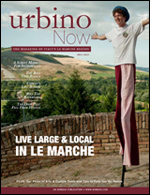The best eyewitness to Urbino’s storied history is the Piazza Repubblica, which has witnessed the march of time from the Renaissance through Fascism, the Cultural Revolution and today’s army of partying students.
URBINO, Italy – Near midnight, a group of young men spills into the Piazza Repubblica, stumbling and shuffling over a cobblestone roadway. They gather near a fountain ringed with beer and wine bottles emptied over the last few hours. The leader pauses, then raises a vuvuzela—the infernal horn made famous by the World Cup in South Africa—and blasts staccato notes into the air. His ever-growing horde cheers wildly, as if his vuvuzela was spraying money, enough to make the college degrees many of them just earned moot.
Visitors who come to this piazza after 10 p.m. might think it only serves as a party platform for drunken University of Urbino students. But twelve hours before that, this square hosted middle-aged and elderly people calmly sipping espresso and nibbling croissants. Fifty years earlier, a burgeoning leftist student movement held protests here. Ten years before that residents gathered to watch the city’s first TV together. And two and a half centuries before that, this city’s heart began to beat.
For generations the Piazza Repubblica has served as the social linchpin and historical stage of the city.
Though it’s a staple of present-day Urbino, the Piazza Repubblica has deep historical roots. It began to shift towards its current form in 1700, when Urbino-born Giovanni Albani became Pope Clement XI. The new Pope funneled resources towards the development of Urbino, concentrating on the Piazza Repubblica. His efforts worked, and the Piazza thrived. Decades later, in the 1800s, a pair of theatres further enhanced the area, and an arcade was built on the edge of the square to shelter visitors from the elements.
The Pope’s interest in the Piazza Repubblica is easy to explain, given the importance of piazzas in Italian culture. The Roman Empire, for instance, laid out its towns where two main roads met, creating natural piazzas. In Siena, the city wards have competed in Palio di Senia—a horse race—since 1656 using the Piazza del Campo as a staging ground to keep historic rivalries alive and the people paradoxically united through competition.
Similarly, Urbino’s own Piazza Repubblica is located on a hill at a convergence of four roads, two going up and two going down. Bars and restaurants ring the area, sporting names like Caffé Degli Archi and Ristorante San Giovanni. The neon signs of some buildings provide a counterpoint to the ancient architecture. Other establishments favor a simpler approach: one below-street-level pizza joint is advertised by a painted black and white sign that simply reads, “PIZZA.” Anyone over six feet tall has to duck to enter the place, and it’s known to many American visitors as the “Pizza Hole.”
The Piazza wakes up early; cleanup crews and breakfast eaters are out by 7 a.m.. Trucks soon arrive, enough of them to obscure the fountain from view, and workers deliver food and drink to the restaurants. Buses and a tour-giving tram, which looks it belongs in a Disney park, use the Piazza as a drop-off and pickup area. Cars and motorcycles also weave about. Any drivers who pass through must pick their way around tourists and residents.
To Urbino residents, the Piazza Repubblica’s importance is huge. Gamba Stefano, a middle-aged man who runs a shirt store just off the Piazza, said that for sixty years his family has relied on the Piazza to funnel customers in. The store targets students, who hang out in the Piazza, and tourists, who instinctively gravitate towards it.
The crowd goes through a slow but noticeable change over the course of the day: people of all ages are out from the morning until the evening, at which point the older crowd, which favors white wine and cappuccinos, gives way to students, who favor giant bottles of Peroni and Birra Moretti.
Opinions on the evening crowd vary. A gray-haired taxi driver said through an interpreter, “The students are loud and cause problems. It’s difficult to park, and broken glass is everywhere. And the bathrooms are closed, so there’s piss everywhere.”
But Carmen Staccioli, who works with her husband at their bar, Café Deggli Archi, recognizes the economic value of the nightlife. “We [cater to] the students,” she said. “Without them, we’d have less work.”
Come June, many of those students use the piazza for graduation celebrations. Once they take their last exam, each graduate dons a laurel crown, then heads out to the fountain for champagne and picture-taking. They tend to drink a little, talk a little, drink some more, talk some more, and then move to another area of the Piazza for more pictures and drinking.
Friends arrive. Groups blend together. The cycle repeats until nighttime, at which point the crowd becomes huge, amorphous and loud. The noise culminates when the vuvuzela-wielder arrives. Chants and dancing spontaneously break out, though the only dance move many of the young men display consists of hopping up and down with a fist in the air.
Despite all the drinking, the bars themselves are surprisingly empty. Instead of sitting inside with only a few people, the students celebrate outside with an entire city.
Video
Slideshow
Click on Image to Show in Lightbox.












